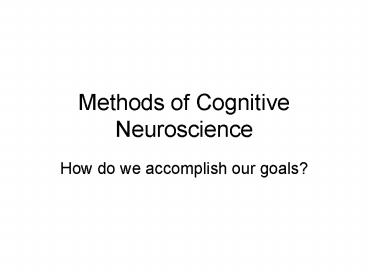Methods of Cognitive Neuroscience PowerPoint PPT Presentation
1 / 13
Title: Methods of Cognitive Neuroscience
1
Methods of Cognitive Neuroscience
- How do we accomplish our goals?
2
Science
- What is science?
- What is the purpose of science?
- Is Science about finding Truth?
3
Whither Cognitive Science?
- How do we observe something that cant be seen?
- How do we theorize about something that cannot be
observed? - We have to really know what it is were analyzing.
4
What were studying
- What were looking at is how the mind processes
information. - What does that mean?
- Process and Representation
5
Representation
- The manner in which information is stored in the
mind. - Analogous to different representations on a
computer - text, JPG, MP3, WMV, etc.
6
Process
- The means by which those representations are
manipulated. - Once again, we can use the computer analogy
e-mail, Word, iTunes, Quicktime, etc.
7
Cognitive Research Methods
- Task Difficulty - Different combinations of
processes and representations should make
different types of tasks more or less difficult.
Determining which properties of tasks make them
easier or harder can shed light on what processes
and representations are being used. - Reaction time
- Error rate
- Task performance time
- Ex the Chinese Ring puzzle
8
More methods
- Task Performance - examine how people perform
various tasks to try and understand the
underlying processes and representations - Verbal protocols
- Eye tracking
- Mouse tracking
- Brain-damaged patients
9
Two Goals
- Localization of function - At the macro level,
Cognitive Neuroscience tries to examine where in
the brain various cognitive operations take
place. - Neural computation - At the micro level, we try
to understand how the brain performs various
operations.
10
Localization of function
- Post-mortem lesion studies - Find someone who
displays an interesting cognitive deficit. When
they die, study their brain for where the damaged
tissue was. (Phineas Gage, Brocas Wernickes
areas) - Human-lesion studies - These days, we can take
pictures of the brain while its still in the
skull (CAT, MRI) an determine where the lesions
are while someone is still alive. (Prosopagnosia,
optic aphasia)
11
More localization
- Animal lesion studies - Human lesions are messy
and uncontrolled. No two people ever have the
exact same lesion. With animals, we can control
the characteristics of the lesions. (Area MT) - Single-cell recording - Also with animals, we can
attach electrodes to neurons and measure the
firing pattern of individual neurons. (Feature
detectors in area V1)
12
But wait! Theres more
- Brain imaging - Modern technology provides us the
ability to, in very broad strokes, examine what
the brain is doing while a person is actively
performing a cognitive task. (Face recognition,
spatial processing) - Brain stimulation - People are kept awake during
brain surgery. Use the opportunity. (Motor and
somatosensory homunculi)
13
Neural computation
- Physical modeling - Understand the properties of
neurons, how they share information and what-not,
and try to understand how these properties can
lead to complex computations. (opponent
processes, how feature detectors are calculated). - Computational modeling - Neural networks are
computer models of how groups of neurons behave.
Use these models to try and better understand
cognitive processing in the brain.

